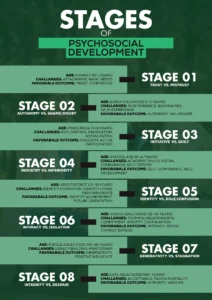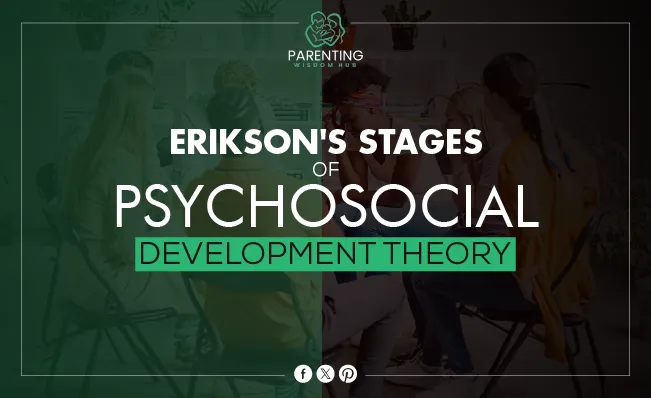Introduction
German-American developmental psychologist and psychoanalyst Erik Erikson, born in 1902, is famous for his psychosocial development theory. His work expanded Freud’s theories by stressing social experience throughout life. His developmental theory centers on the identity crisis that Erikson presented. He made lasting contributions to psychology and human development.
Psychosocial development explains human transformation. Erikson believed social interactions and relationships shaped a person’s self-image and ability to overcome challenges. Understanding these stages promotes personal growth, mental health, and well-being from birth to death.
This blog discusses Erikson’s eight psychological growth stages and their challenges and achievements. It will also discuss Erikson’s theory’s shortcomings and applications in education, psychology, and parenting. Through this exploration, we want to illustrate how psychological growth influences us.
Background on Erik Erikson
Erik Erikson was born June 15, 1902, in Frankfurt, Germany. After his mother and stepfather reared him, he studied art and travelled instead of attending school. He became interested in psychoanalysis after meeting Anna Freud, Sigmund Freud’s daughter while teaching painting in Vienna. He studied psychoanalysis in Vienna after this experience.
Erikson’s most significant impact was psychoanalysis’ father, Sigmund Freud. Freud’s unconscious mind and psychosexual formation theories influenced Erikson. Erikson expanded Freud’s theories by including social and cultural variables in development. A child psychoanalyst, Anna Freud, influenced Erikson’s understanding of human development.
Following training, Erikson taught at Harvard, Yale, and Berkeley in the 1930s. Psychoanalytic theory, sociocultural integration, and innovative concepts defined his academic career. “Identity: Youth and Crisis” (1968) analyzes identity crises, while “Childhood and Society” (1950) established Erikson’s eight-stage psychosocial development theory. His comprehensive perspective impacted psychology and growth.
Psychosocial Development
According to Erik Erikson, psychosocial development outlines eight life stages. Upbeat personality and psychological development entail resolving psychological issues at each stage. Erikson’s theory stresses social bonds and communities from infancy to old age, while Freud emphasizes early childhood and sexual development.
Relevance of psychosocial development in modern psychology
Modern psychology resembles Erikson’s psychosocial development hypothesis. This broad viewpoint helps psychologists understand and help people forever. Nowadays, psychology stresses connections and social interactions. Finally, Erikson’s emphasis on identity-building and developmental crises aids educators, parents, and mental health practitioners comprehend self-esteem, mental health, and social conduct.
The Eight Stages of Psychosocial Development
Erik Erikson’s psychosocial development theory has eight stages, from infancy to late maturity. Each stage has a pivotal conflict. Resolving these issues improves personality and social relationships while failing can hinder personal growth and relationships.
Importance of each stage in human development
Trust vs. Mistrust (Infancy: 0-1 year)
- Importance: This stage involves caretakers meeting the infant’s necessities. The successful resolution builds trust and security for future partnerships.
Autonomy vs. Shame and Doubt (Early Childhood: 1-3 years)
- Importance: Children gain independence and control over their physical abilities and autonomy here. Failure can cause humiliation and doubt, while success boosts confidence and self-control.
Initiative vs. Guilt (Preschool: 3-6 years)
- Importance: Play and other social interactions help children take charge of their surroundings. Failure in this stage might cause remorse and hesitancy, while success encourages initiative.
Industry vs. Inferiority (School Age: 6-12 years)
- Importance: At this age, kids face new social and academic challenges. Failure makes people feel inferior, whereas success makes them feel competent.
Identity vs. Role Confusion (Adolescence: 12-18 years)
- Importance: Teens discover their freedom and self-identity. Successful resolution gives life purpose, whereas failure causes role confusion and future uncertainty.
Intimacy vs. Isolation (Young Adulthood: 18-40 years)
- Importance: Young adults need close, meaningful relationships. Failure leads to loneliness and isolation, while success builds deep relationships.
Generativity vs. Stagnation (Middle Adulthood: 40-65 years)
- Importance: Parents and promising changemakers must create something lasting throughout this stage. Success offers help and accomplishment, while failure brings superficial global engagement.
Integrity vs. Despair (Late Adulthood: 65+ years)
- Importance: Those who are content with their lives feel integrity, whereas those who are not may regret and despair.
Understanding these stages and their relevance can illuminate personal development and the importance of social ties and experiences in shaping us.
Stage 1: Trust vs. Mistrust (Infancy: 0-1 year)
Description of the stage
In their first year, infants depend on their caregivers for food, warmth, and comfort. It establishes future relationships and interactions with the world, making it vital. When caregivers regularly address their needs, infants trust them and feel secure.
Challenges and milestones
- Attachment: Infants bond with their parents. This bond helps them develop emotionally and shapes their future relationships.
- Basic needs: Building trust requires feeding, changing, and calming the newborn. Caregiving must be consistent and responsive throughout this stage.
Outcomes of successfully resolving the crisis
- Trust: Trusting infants feel secure and confident that their needs will be addressed. Trust underpins good relationships and a positive mindset.
- Confidence: Infants can explore their environment and gain confidence and independence with trusted caretakers.
Overall, Erikson’s psychosocial development begins with infants learning to trust people and the world. Trust underpins social and emotional growth.
Stage 2: Autonomy vs. Shame and Doubt (Early Childhood: 1-3 years)
Description of the stage
Children between 1 and 3 years old begin to explore their independence and develop a sense of autonomy. They want to make choices and control their environment but also need their caregivers for support and guidance.
Challenges and milestones
- Independence: Children like to do things independently, like getting dressed, eating, and discovering their surroundings.
- Boundaries: As they try to be independent, they start to push the limits and may act defiantly.
- Self-expression: At this time, children’s language skills improve, making it easier for them to say what they want and need.
Outcomes of successfully resolving the crisis
- Autonomy: Successfully navigating this time gives kids independence. They trust their abilities and are open to new challenges.
- Willpower: They also gain willpower by realizing they can control their environment and make life decisions.
In conclusion, Erikson’s second psychosocial stage is vital for children’s development when they balance independence with caregiver support. Successfully navigating this stage builds emotional development and self-confidence.
Stage 3: Initiative vs. Guilt (Preschool: 3-6 years)
Description of the stage
Children assert themselves more at preschool, usually between 3 and 6 years old. Plan events, design games, and start group activities. Imagination and curiosity drive this stage’s desire to explore and interact with others.
Challenges and milestones
- Exploration: Children are curious and often initiate exploration and experimentation.
- Imagination: Their imaginations flourish as children play fantasy games and develop elaborate stories.
- Socialization: Children learn to collaborate and engage with peers in preschool.
Outcomes of successfully resolving the crisis
- Initiative: Children who pass this stage gain initiative and purpose. They’re confident in their ability to tackle new problems and achieve goals.
- Direction: They also realize that their behaviors affect their surroundings and others, giving them direction and purpose.
In conclusion, Erikson’s third stage of psychosocial development is crucial for children’s freedom and active participation. Success in this stage lays the groundwork for future social and emotional development and life purpose.
Stage 4: Industry vs. Inferiority (School Age: 6-12 years)
Description of the stage
Erikson’s fourth stage of psychosocial development begins during school between 6 and 12 years old. This level emphasizes skill and activity mastery. Children at this age want to study and show off.
Challenges and milestones
- Academic Skills: Reading, writing, and math are introduced to children in formal education.
- Social Comparison: They start comparing themselves to peers and may feel superior or inferior.
- Self-Esteem: Positive self-esteem is vital as youngsters seek validation and credit for their achievements.
Outcomes of successfully resolving the crisis
- Industry: Children who master this stage gain industry and competence. They believe they can succeed and want to learn.
- Self-Confidence: They also gain a lot of self-confidence, believing in their skills and being proud of their accomplishments.
In conclusion, Erikson’s psychosocial development’s fourth stage is crucial for children’s skill development. Success in this stage builds self-confidence and a sense of accomplishment for future academic and personal success.
Stage 5: Identity vs. Role Confusion (Adolescence: 12-18 years)
Description of the stage
Teenagehood, from 12 to 18, is fundamental to Erikson’s psychosocial development theory. The search for self and identity dominates this period. Adolescents explore diverse roles, attitudes, and beliefs as they search for an identity.
Challenges and milestones
- Identity Formation: Teenagers ask, “Who am I?” and “What do I believe in?” They can explore different identities through dress, music, and social groupings.
- Peer Influence: When teens are young, their peers significantly impact their identities, leading to cliques and peer pressure.
- Identity Crisis: In this period, teenagers may have an identity crisis and worry about their future and role in the world.
Outcomes of successfully resolving the crisis
- Identity Achievement: Adolescents who survive this stage establish strong identities. They know themselves, their beliefs, and their role in the world.
- Self-Confidence: They also gain self-confidence and a sense of direction that helps them make important choices in life.
In conclusion, the fifth stage of Erikson’s psychosocial development theory is crucial for adolescents’ identity exploration. Completing this stage gives a strong sense of self and a clear future orientation.
Stage 6: Intimacy vs. Isolation (Young Adulthood: 18-40 years)
Description of the stage
Young adulthood (18–40) is about intimacy and personal relationships. During this period, people want profound romantic and social bonds. It is essential for building relationships and belonging.
Challenges and milestones
- Forming Relationships: Young people try to build close relationships to balance their need for closeness with their desire for independence.
- Commitment: At this time, people make promises to essential people in their lives, like in friendships or romantic relationships.
- Identity Continuation: Teenagers and young people want to be in relationships that strengthen their sense of self, not ones that weaken it.
Outcomes of successfully resolving the crisis
- Intimacy: Those who survive this period develop intimacy and deep relationships. They build deep, meaningful relationships.
- Social Connectedness: They also feel like they fit in and are connected to others, which improves their overall health and happiness.
In conclusion, Erikson’s psychosocial development theory’s sixth stage is crucial for young adults to build close relationships and connect with others. After overcoming this stage, relationships and a sense of belonging flourish.
Stage 7: Generativity vs. Stagnation (Middle Adulthood: 40-65 years)
Description of the stage
Middle adulthood, from 40 to 65, is about giving back and leaving a legacy. In this stage, people reflect on their lives and try to help others. This stage is vital for personal growth and fulfillment.
Challenges and milestones
- Contributing to Society: People try to contribute to society through work, family, and community involvement.
- Legacy Building: This stage comprises life reflection and legacy planning.
- Mentorship: Middle-aged adults may help and guide younger people by taking on mentorship jobs.
Outcomes of successfully resolving the crisis
- Generativity: Successfully navigating this stage makes people feel valuable and fulfilled in their social efforts.
- Positive Influence: Their behaviors and interactions positively impact future generations.
In summation, the seventh stage of Erikson’s psychosocial development theory is crucial for middle adults to leave a meaningful legacy and help others. Completing this stage brings later happiness.
Stage 8: Integrity vs. Despair (Late Adulthood: 65+ years)
Description of the stage
Late adulthood—typically 65 and older—is a time of reflection and self-discovery. This stage is vital as people reflect on their successes and disappointments to attain fulfillment.
Challenges and milestones
- Life Review: People in their later years often undergo a “life review,” in which they reflect on their relationships and events.
- Acceptance: At this time, you accept your choices and try to find meaning in them.
- Facing Mortality: Adults who are getting old also have to face their fate and accept that they will die.
Outcomes of successfully resolving the crisis
- Integrity: People who make it through this stage have a strong sense of ethics and are happy with their lives and decisions.
- Wisdom: They also learn much-needed knowledge to share with future generations to help them make decisions and see things more clearly.
In conclusion, the eighth and final stage of Erikson’s psychosocial development theory is crucial for late adults seeking meaning and acceptance. Resolving this step brings closure and contentment, allowing people to die with dignity.
Key Limitation of Erik Erikson’s Eight-Stage Theory of Psychosocial Development
The eight-stage psychosocial development model overemphasizes chronological age. Based on Erikson’s theory, humans must progress by age. Simplifying human development ignores its diversity. Individual, societal, and other factors might cause psychosocial difficulties at different times. Due to this, the age-based paradigm may miss some psychological well-being routes.
Conclusion
Erik Erikson’s psychosocial development theory covers human development from infancy to late maturity. It stresses the role of social ties in developing personality and identity. Each stage brings distinct challenges and milestones that build self-esteem.
Today’s society benefits from Erikson’s notion of human development across the lifespan. It emphasizes social and emotional development, cognitive progress, and how early experiences shape later outcomes. Understanding Erikson’s theory can help educators, psychologists, and counselors promote healthy development and well-being.


